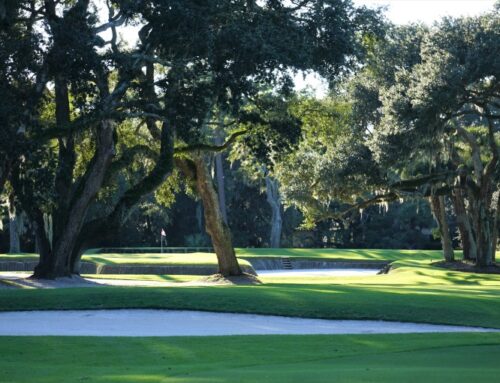Monterey Peninsula Country Club (Dunes)
California, United States of America
Green Keeper: Bob Zoller

The Dunes Course at MPCC has it all: a mix of inland and dunesland features (sometimes both in the same hole as here at the 11th)…
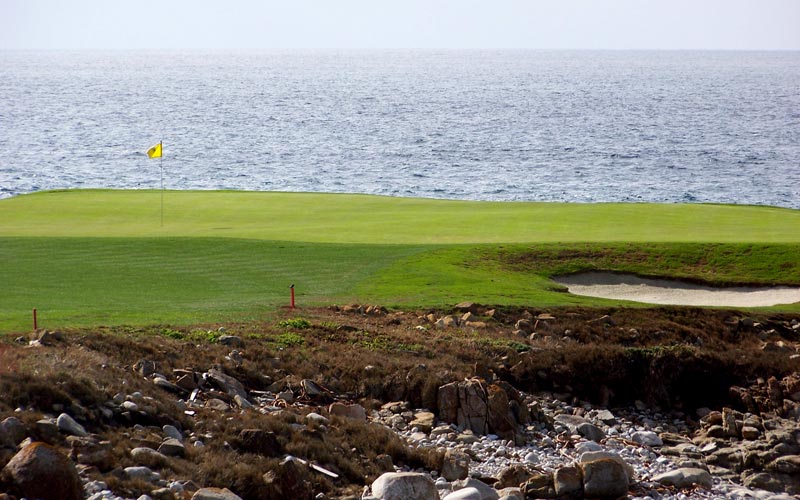
…before getting to the rocky coastline at the 14th.
This website profiles nine Seth Raynor courses because his work leaves much to be admired. And yet, the Club Board at Monterey Peninsula Country Club made the right decision to modify their Seth Raynor Dunes Course at Monterey Peninsula golf course rather than restore it. How can this be?
Several reasons. First, Seth Raynor died in Florida at a relatively young age while the Dunes Course at Monterey Peninsula was still under construction. Similar to what happened at Lookout Mountain, his design team led by Charles Banks was inundated with numerous projects at the time of Seth Raynor‘s death, and were hard pressed to find the time to devote to so many projects.
In this case, the local Robert Hunter was called in to finish the Dunes Course at Monterey Peninsula and Hunter shared Alister MacKenzie’s view (as expressed in a letter to Samuel Morse in January, 1932)that ‘…golf course construction is an artist’s work and not an engineer’s job.’ Hunter does not appear to have been captivated by Seth Raynor’s style in general and certainly, the architectural styles of a Cypress Point Valley Club of Montecito will never be confused with a Fishers Island or a Camargo.
Indeed, in the preface to Hunter’s The Links (which was published the same year that the Dunes Course at Monterey Peninsula opened), Hunter praises the work of numerous architects including Colt, Abercromby, Macdonald, Travis, Ross, Emmett, Tillinghast and MacKenzie. Seth Raynor’s name is conspicuous in its absence, especially given Hunter’s involvement at the time with the Dunes Course at Monterey Peninsula.
As all of this relates to the Dunes Course at Monterey Peninsula today, some Seth Raynor fans, which are a tough group to please, may be a touch disappointed not to find more of the famous engineer’s crisp lines and dramatic steep faced bunkering at the Dunes Course at Monterey Peninsula. However, many such features never existed to begin with as Hunter preferred a more natural – and less engineered – finished product.
Importantly, it needs to be noted that the construction budget from Samuel Morse was limited and this manifested itself underneath the ground where the drainage work was inadequate for Dunes Course at Monterey Peninsula since it is exposed to torrential rains. When these famous rains pelt down on the Monterey-Carmel area, the more inland fairways in particular puddled and remained soft for days. Poor grass coverage was a result and more importantly, the desired fairway firmness was unachievable. Tee balls would actually bounce back toward the golfer.
Given its windy location, the ability to play the game close to the ground is crucial, so something needed to be done. In 1998, the Club Board interviewed several different architects about improving the drainage on the Dunes Course at Monterey Peninsula. Firstly, they wanted to provide the infrastructure to carry away the large volume of surface water and secondly, to have a minimum grade of at least 1% throughout the Dunes Course at Monterey Peninsula.
Rees Jones’s plan of roughing up the flat, cupped fairways made the most sense to the Board and they proceeded with him.
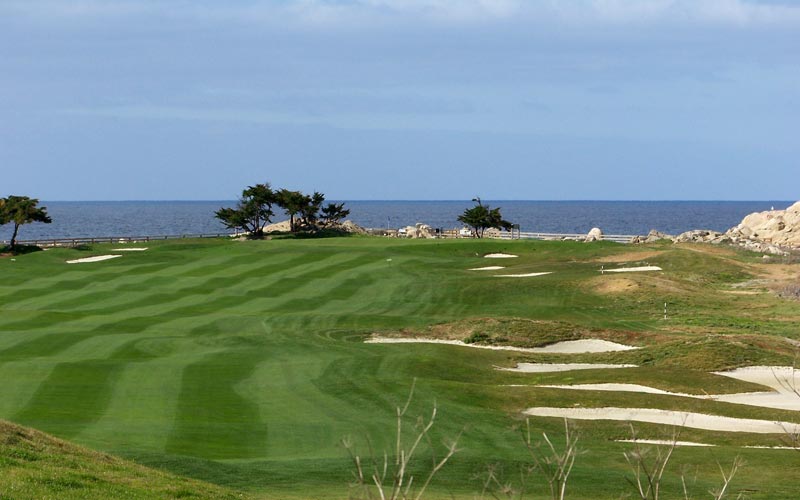
An example of how Jones roughed up the flat fairways to improve drainage. Pictured is the 13th.
Though his work was brought on by the desire to improve specifically the drainage, Rees Jones and the Board used this opportunity to enhance Raynor’s unfinished design, with the fourteenth hole being the most obvious example.
Originally constructed in 1926, the fourteenth was a half-hearted effort by Seth Raynor’s team that highlighted their limited budget. While it existed for over 75 years between 17 Mile Drive and the Pacific Ocean, its location was its sole merit as the tee and the green were as non-descript as one could imagine for such a glorious setting. With more resources at his disposal, Rees Jones did what Seth Raynor would have undoubtedly done if he had been on-site during construction: He pushed both the green and the tee as far right and onto the coastline as possible. This one shotter is now a white knuckler and lives up to the jaw-dropping setting.
Some traditionalists contend that Seth Raynor kept the tee and green well away from the Ocean for agronomic concerns. However, the angle of the shoreline and the arrangement of this rocky point are such that the waves break well back from the green. No, the fact is that Seth Raynor didn’t maximize the hole’s potential and to have faithfully restored it would have been nonsensical.
Rees Jones did further work to showcase the natural beauty of the property, and it is this natural beauty that ultimately distinguishes Dunes Course at Monterey Peninsula from so many others. For instance, a dense grove of cypress trees and underbrush ran along the last 100 yards to the right of the twelfth fairway. Since moving such a jungle is both time consuming and costly, and since it didn’t directly affect play, it had been left untouched for decades. Rees Jones, equipped with more resources, cleared the underbrush, and thus opened up panaramic views down the coastline. At the same time, wind now plays an even bigger role on the approach shot. Thankfully, of course, with the improved fairway drainage and the resulting firmness, the golfer can beat Mr. Wind by playing the low running shot.
Holes to Note
Fourth hole, 230 yards; An unusually difficult Biarritz because of the right to left sloping green. Most Biarritz offer a reasonably large target but this green follows the slope of the land down toward the distant Ocean. Missing the hole location to the right is verbotten and the golfer must stay to the left of the hole even if that means going into the left hand bunkers which leave a relatively straightfoward uphill splash shot.
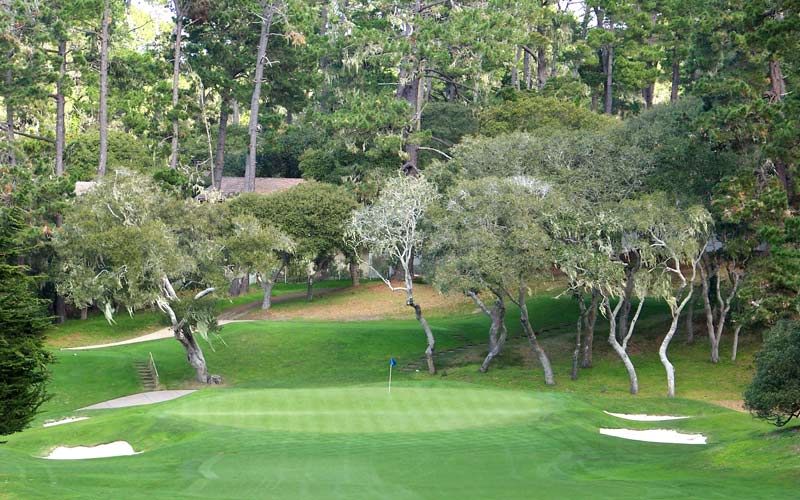
The view from the elevated 4th tee to the green well below. The right to left tilt of the green as well as the classic Biarritz swale is much in evidence.
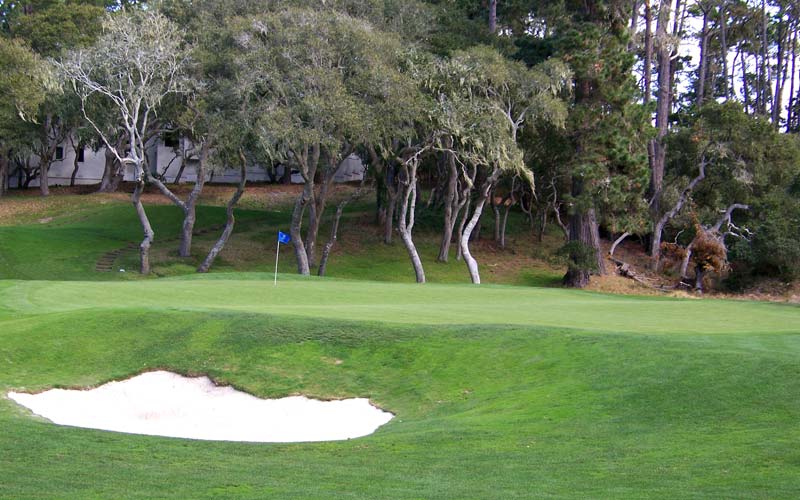
Sixth hole, 430 yards; This hole had a poorly placed bunker on the outside of the dogleg and Jones filled it in and created a long bunker on the inside of the dogleg, making the tee ball more strategic. By the green, he restored the back bunker to its original depth of eight feet and made the bottom flat in true Seth Raynor style.
Seventh hole, 170 yards; A wonderful version of an Eden hole with the clean lines of the green’s horizon allowing the golfer’s eye to catch the first glimpse of the Pacific Ocean. For such a master at routing golf courses, this one shotter played from the top of one hill across a valley to the top of another must have been one of the first holes that Seth Raynor settled upon early on during the routing process.
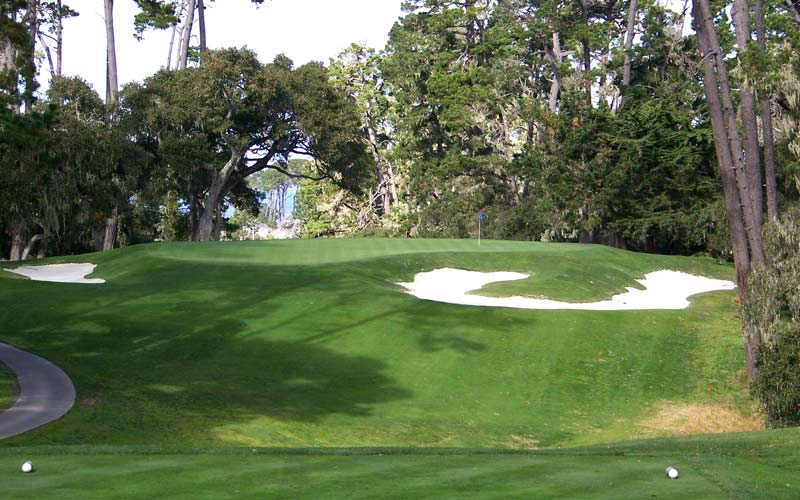
As with The Eden at The Old Course at St. Andrews, part the playing fear is what happens to one’s tee ball that sails long. Charles Blair Macdonald’s only criticism of the Eden in Scotland was that the golfer could play the hole with just his putter; no doubt he would have loved Raynor’s version here.
Eighth hole, 400 yards; This downhiller was once a standout. Little was done to it during the renovation, and yet it no longer seems to be clearly better than the other holes featured in this Holes to Note section. The conclusion? Jones did a fine job of raising the overall standard of these other holes, and thus the course in general.
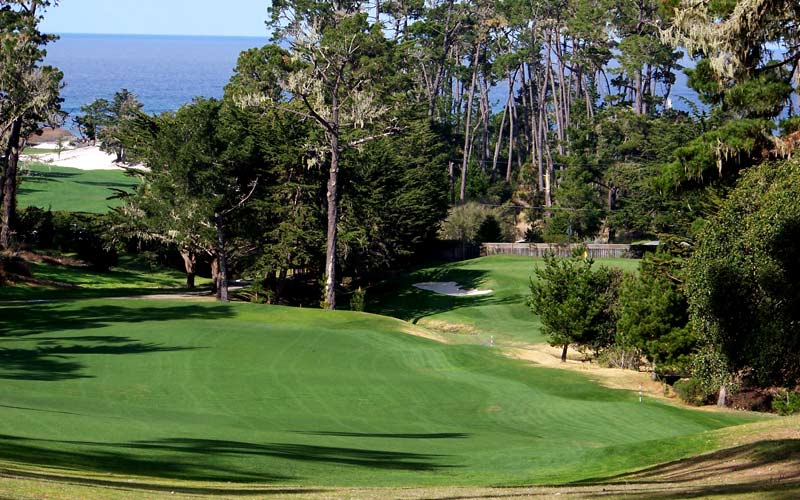
One of the most inspiring shots on the course is to watch a well struck tee ball at the 8th as it falls from the sky to the wide fairway well below.
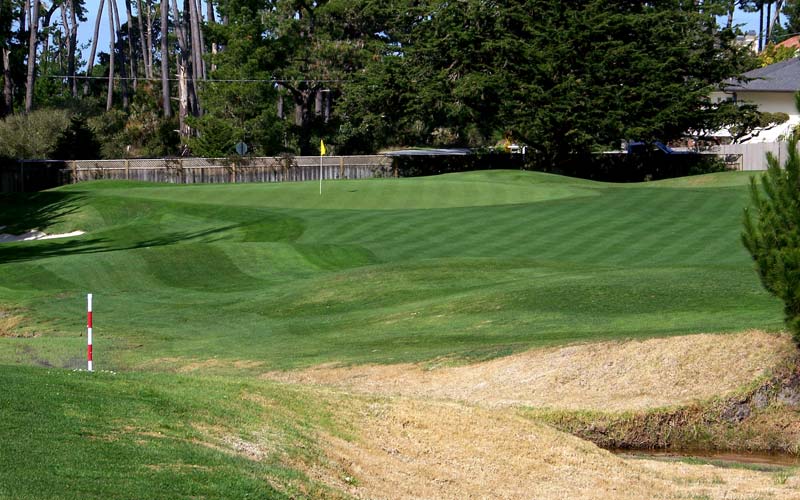
Assuming the golfer finds the fairway off the tee, the creek that bisects the fairway shouldn’t be a factor.
Ninth hole, 480 yards; None too taxing unless you give the green a go in two shots. In that case, the golfer must cross a natural sand ridge that juts into the fairway some thirty yards shy of the green. The contrast of the sand, ice plant, cypress trees and fairway is invigorating and signals one’s proximity to the Ocean, which the golfer now hears for the first time.
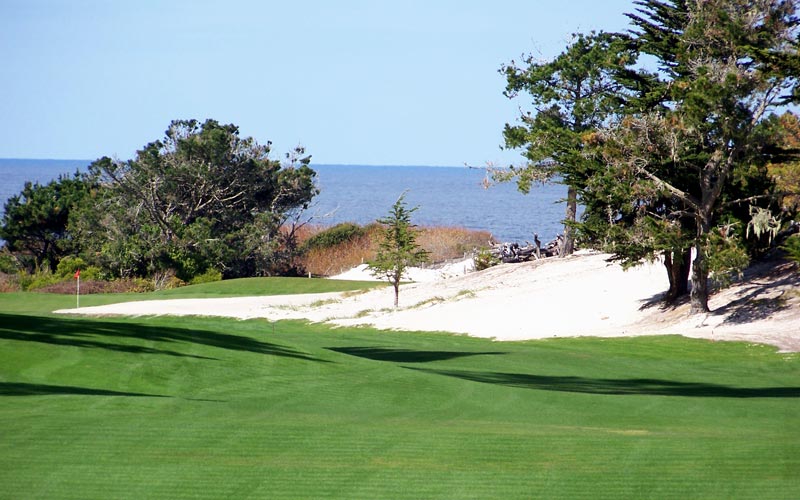
The contrasts in colors down the 9th and the sound of the Ocean provide an inspired setting for golf, even by Monterey Peninsula’s own impossibly high standards.
Tenth hole, 165 yards; The tee is perched on top of a sand dune with the green below and the Pacific beyond. To one’s right is Spanish Bay. To one’s left is the stunning coastline heading toward Cypress Point. This Short is simple enough except for that other dimension: The wind, which plays havoc with the best laid plans. Placing his Short on the windest spot on the course was a shrewd move by Raynor as few Americans properly control their ball flight, and this hole ruthlessly exposes that flaw.

In any kind of wind, this Short green proves to be an elusive target.
Thirteenth hole, 505 yards; The original green complex was devoid of interest and big hitters often got the ball up and down from any area around the green for an easy birdie. Jones created a tightly mown chipping area to the left of the green that changed all that.
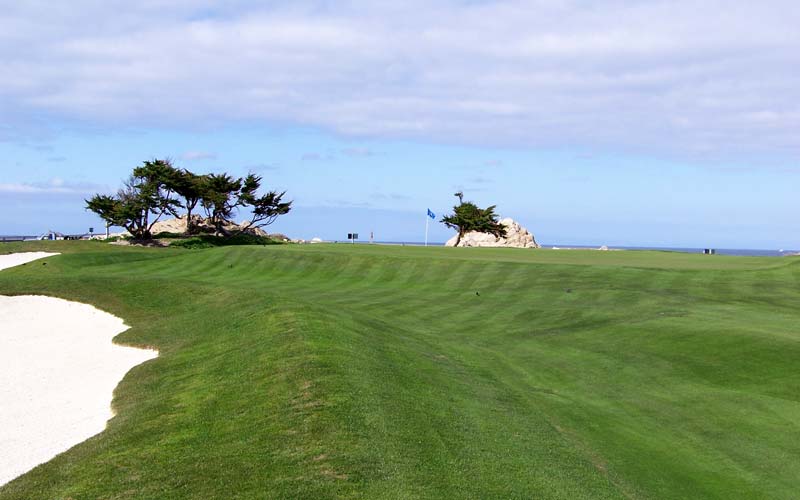
The chipping area immensely improved the 13th green complex.
Fourteenth hole, 175 yards; The nearby on-lookers from a State coastal lookout point guarantee the golfer an audience as he flights his tee ball over the rocks and crashing surf to the distant green.

Just re-turfed, it is indeed accurate to say that the 14th tee is along the shoreline!
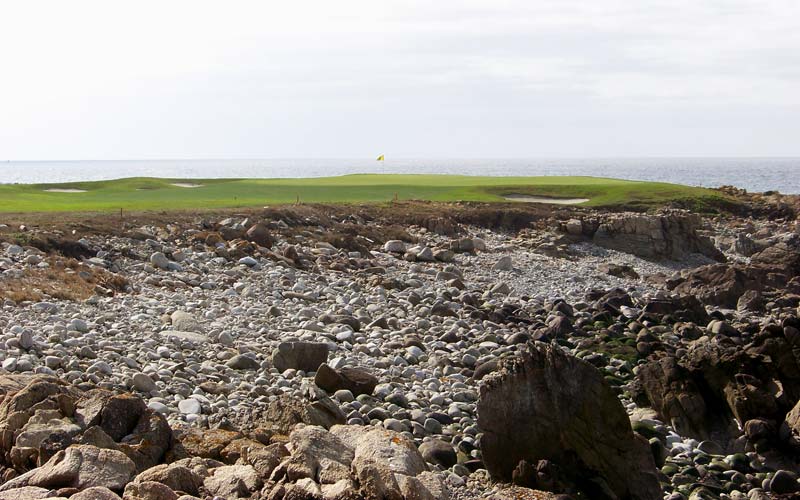
The view from 14th tee makes clear the golfer’s task.
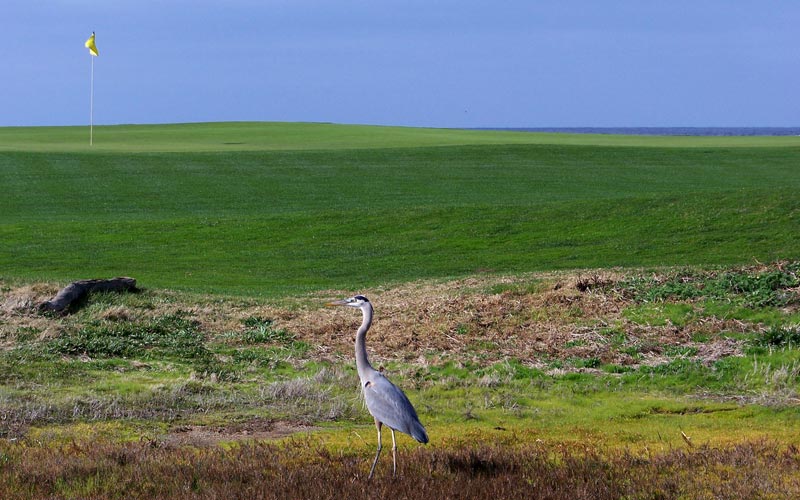
The 14th is obviously a great environment, both golfers and non-golfers alike. As seen from the left of the 14th green, no mounds clutter the green’s glorious backdrop.
Sixteenth hole, 380 yards; Holes that feature some bend or curve are obviously desirable for windy sites as in that manner, the golfer is always caught second guessing himself on the exact affect the wind will have on any particular shot. Yet, many links in the United Kingdom lack such holes. Indeed, Old Tom Morris preferred straight holes such as those found at Lundin Golf Club. Thankfully, Raynor did not and the Dunes course is more engaging for it, especially as one approaches the Pacific with curving holes such as the eighth, ninth, thirteenth, and fifteenth. Interestingly enough, Raynor’s routing had the sixteenth as a straightaway 340 yard hole. Ray Leach, who Johnny Miller claimed in Golf Digest was the finest striker of a golf ball he ever encountered, once drove the fifth, eleventh and sixteenth greens of the Dunes in a round in 1982. The current dog-leg left hole was suggested by Bill Brandt and Andy Nottenkamper, a five time club champion, in the early 1990s. John Zoller, the father of the current Green Keeper for both courses at MPCC, created this clever dogleg shortly thereafter when he was the Green Keeper here (and before he went onto become the General Manager, then a head figure for the Pebble Beach Corp, then General Manager of the Northern California Golf Association and finally running Tehama for Clint Eastwood before passing away in early 2007).

The dogleg left 16th leaves the golfer guessing as to the effect of the wind on his approach shot, with the stunning backdrop offering some consulation for a miscalculation. The day’s hole location is one of the single toughest on the course.
Though Raynor died before the Dunes Course was completed, his exemplary routing remains the highlight as it takes full advantage of the property’s natural beauty. Indeed, Raynor historian George Bahto considers Raynor’s ‘routing skills as his strongest asset.’
In the case of the Dunes course, the first three holes go uphill and away from the ocean. These holes were never going to make the course but individually, they are each fine holes (in fact, Rees’s bold contouring back left on the second green makes for an inspiring hole location). Having rid himself of the least appealing land at the start, Raynor turns things up a notch with the downhill Bairritz fourth and the golf stays exciting through at least the sixteenth hole. The last two holes again head away from the Ocean and toward the clubhouse. The golfer can’t help but appreciate how much more appealing such a sequence is than the one at nearby Spyglass Hill, where its blazing start fizzles out in a series of fine – but uninspired – holes.
The Board at Monterey Peninsula Country Club had no easy decision. To renovate rather than restore a Raynor course was a difficult decision, especially given the current euphoria that surrounds Raynor courses. However, for drainage reasons, coupled with the fact that Raynor never saw this design through himself, the Board made the right decision. The course plays faster and firmer than it ever has and the golfer delights in having all options available to him.
In summary, the golf on offer here today is the best it has ever been – surely, that is what matters the most?

The proud Spanish style clubhouse provides a perfect vantage point for members to soak up the action along the three shot Home hole.

MPCC is justly famed for its relaxing environment.
The End




![The Park, West Palm (Lit 9) [2023]](https://golfclubatlas.com/wp-content/uploads/2024/12/IMG_7092-2-scaled-500x383.jpg)



